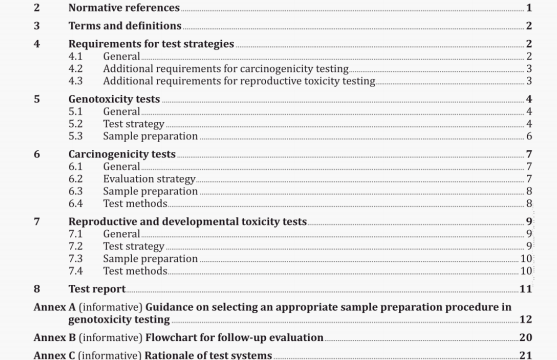ISO 10993-3 pdf download – Biological evaluation of medical devices一 Part 3: Tests for genotoxicity, carcinogenicity and reproductive toxicity.
Where applicable, the in viva test for chromosomal damage in rodent haemapoietic cells shall be performed using two extracts (see ISO 10993.12 or Annex A). The preferred application route of polar vehicles is intravenously. The preferred application route for the non.polar vehicles Is intraperitoneally.
An En vivo assay Is not necessary, If the user can demonstrate that the quantities of extractables from the test article are less than the amount of material that would induce a positive response with a potent velI-characterized in viva mirronudeus genotoxin.
An example is cisplatin (CAS no. 15663-27-1), which was shown a positive response at 0.3 mg/kg. see Reference.lJ
5.2.3 Follow.up evaluation
If genotc)xlclty testing is performed in accordance with 5.2,2 and if the results of the two in vitro tests are negative, further genotoxicity testing in animals is unnecessary.
If any test is positive, the following step-wise procedure is applicable (see also Annex B).
Step 1: Identification of confounding factors In results from the initial set of genotoxicity tests, if available.
a) Identification of confounding factors (e.g. non-physiological conditions, interaction of test article with culture medium, auto-oxidation and cytotoxicity).
h) Identification of metabolic effects (e.g. nature of the exogenous metabolic system, nature of the metabolic profile, unique metabolites).
c) Identification of impurities by chemical characterization (i.e. materials ingredient research or analytical testing).
Step 2 Weight of evidence (WOE) assessment with mechanism and mode of action (MOA) to be considered.
a) Direct DNA reactive versus non direct DNA reactive mode of action.
b) Aneuploidy and polyploidy issues. Is an aneuploidy mechanism involved? Step 3: DecIsion point.
Determine whether the extract from the medical device or chemical of concern isa genotoxin and if.
a) the interpretation of results and WOE/MOA analysis within a toxicological risk assessment framework present a low/negligible concern for patients under the expected usage, or
b) the interpretation of results and WOE/MOA analysis within a toxicological risk assessment framework suggest there may be potential risks for patients under expected usage.
If the determination isa) no further additional tests or evaluation are needed.
If the decision is b). then continue to step 4.
Step 4: Perform risk management.
Either manage risks assuming a genotoxic hazard or select the appropriate in vitro and/or in viva Follow- up testing.
Step 5: Select and run additional in vitro and/or In viva test.
Any in viva test shall be chosen on the basis of the most appropriate end point identified by the in vitro tests,
The decision as to the most appropriate test system shall be justifed and documented.
NOTE Recently, a draft 0ECD guideline for the testing of chemicals on rodent alkaline single cell gel
electrophoresis (Comet) assay is under development for genotoxicity testing. This test might prove valuable for
medical device testing. but at the time of publication of this International Standard the OECD Guideline was not
published.)
An attempt shall be made to demonstrate that the test substance has reached the target organ. For micronucleus test in rodents or metaphase analysis in rodent bone marrow, the bioavailability can be proved by one of the following approaches
-analytical quantification of specific extract compounds in the blood or serum,
test extract induced cytotoxicity to the bone marrow cells,
intravenous route of exposure (for polar vehicles).
If the target organ exposure cannot be demonstrated, a second in vivo test in another target organ shall be performed to verifty the lack of in vivo genotoxicity.
Step 6: Reinterpret all of the accumulated data and determine if the test article is genotoxic.
In some cases, positive in vitro tests may not be relevant. The following should be considered in determining the overall relevance of the in vitro results. This list is not exhaustive but is given as an aid for decision making process.
Only one of the original two in vitro tests performed had a positive result.
b) Further in vitro investigation using similar mechanistic end points do not confirm the positive result.
c) Mechanistic information indicates that positive in vitro results are not relevant to in vivo situations (e.g. high cytotoxicity. osmolality, etc).
d) In vivo testing including evidence that the test sample reached the target organ did not demonstrate a genotoxic efect.
The overall WOE and interpretation of the entire data set shall be documented with the final conclusion.
In some cases, site-specific or genetic end point specific tests might be necessary. In most cases, these tests do not have internationally recognized protocols.
5.3 Sample preparation
Unless the sample can be dissolved in a solvent compatible with the test system, appropriate extraction solvents shall be chosen on the basis of its ability to maximize extraction of the material or medical device to a level at which the concentration of genotoxic residues would be sufficient to produce a positive response in the test system, but without degradation of the device or the test sample. The test system vehicle[S) shall be chosen on the basis of its compatibility with the genotoxicity test system. Tests shall be performed on solutions, suspensions (e.g. Method A in Annex A), extracts (e.g. Method C in Annex A)
or exaggerated extracts (eg. Method B in Annex A] of the finished device (including sterilization if applicable), device material, device component or the individual chemicals of the device.
ISO 10993-3 pdf download – Biological evaluation of medical devices一 Part 3: Tests for genotoxicity, carcinogenicity and reproductive toxicity
